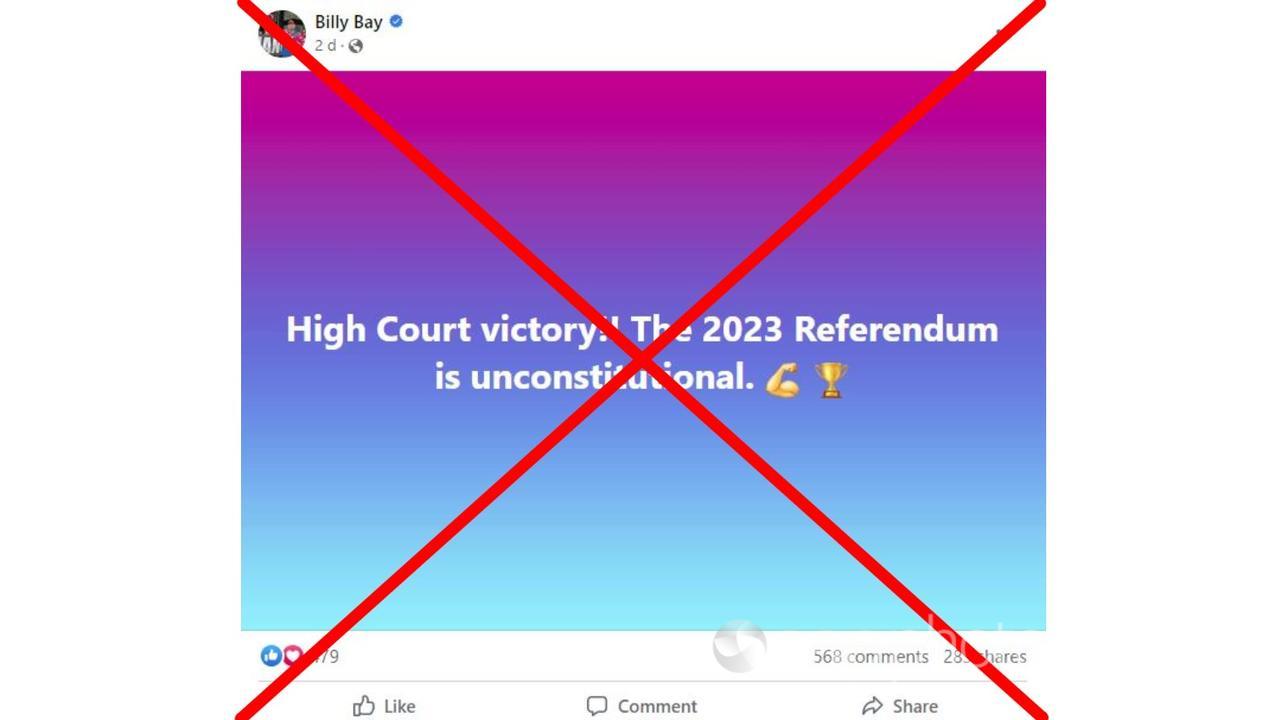It is being claimed that the High Court of Australia has sensationally ruled that the Indigenous voice referendum is unconstitutional.
The claim comes after suspended doctor William Bay, who made headlines in 2022 when he tried to sue the Australian Health Practitioner Regulation Agency, issued the country’s highest court with a writ.
But the claim is false. Not only did the court make no such ruling, it refused to file Mr Bay’s application.
Mr Bay sparked dozens of false social media claims after he posted (archived): “High Court victory!! The 2023 Referendum is unconstitutional.”

“Once the constitutionality of the law underpinning the Referendum is/was challenged it needed to be affirmed by the High Court and by the Court declining to rule we won by default,” he explained in a comment under his post.
Social media users have repeated the claim, with other versions seen here, here, here, here, here, here and here.
Mr Bay made an application to the high court, arguing the referendum ballot paper is “constitutionally invalid” because it is inconsistent with Section 128 of the constitution, which outlines the process for holding a referendum.
“… you cannot put the title, just a one sentence title on the ballot paper, it has to be the full proposed law, as is required by Section 128 of the constitution,” he elaborated in a video (video mark 50mins 10sec).
A high court justice refused to file the writ under Rule 6.07.2 of the High Court on September 5.
Dr Harry Hobbs, a constitutional law expert at the University of Technology Sydney, explained the process for the writ being dismissed.
“Sometimes people file documents that are vexatious, frivolous or clearly have no chance of winning. In these cases, the Registrar can ask a Judge what they should do with it (should they file it, or should they ignore it),” he told AAP FactCheck in an email.
“Rule 6.07.2 of the High Court Rules allows a Judge to issue an order providing that the Registrar should file it, or that they should refuse to file it, unless the person who sent the document has got the permission of a Judge.

“In this case, the High Court has ruled that the document should not be filed until and unless the applicant gets the permission of a Judge of the High Court. It means that the High Court has said that this application is vexatious, frivolous and/or clearly has no chance of winning.”
Dr Hobbs added: “The High Court has not ruled that the referendum is unconstitutional. It has not even considered the question.”
He also addressed Mr Bay’s claim that he had won because a law must be affirmed by the high court if it has been challenged.
“His comment is nonsense,” Dr Hobbs said.
“Nothing has been challenged. The court has not even accepted his submissions alleging a defect because they have no chance of success.”
A spokesman for the high court confirmed to AAP FactCheck it had not found the upcoming referendum to be unconstitutional and had refused to file the writ under rule 6.07.
Dr Hobbs also dismissed Mr Bay’s claim that the full proposed law was required on the ballot paper.
Section 128 of the constitution states “the proposed law shall be submitted in each State and Territory to the electors…” but does not outline requirements for the ballot paper.
This is included in Section 25 and Schedule 1 of the Referendum (Machinery Provisions) Act 1984, which states the ballot paper must set out the “title of the proposed law.”
“There is no requirement that the entire constitutional amendment needs to be written on the paper,” Dr Hobbs said.

“This would make little sense because (1) it is easy to find elsewhere; and (2) in many cases it would be too long.”
An Australian Electoral Commission (AEC) representative seconded Dr Hobbs’s assessment.
“Section 128 of the Constitution outlines the mode of altering the Constitution. The Referendum (Machinery Provisions) Act is the Act that outlines the ballot paper requirements – which the AEC adheres by,” they told AAP FactCheck in an email.
“It outlines that the ballot paper at a referendum includes the title of the proposed law, which is determined by Parliament, followed by the question: ‘Do you approve this proposed alteration?'”
The proposed constitutional amendment is available to view online and in the referendum booklet (Page 4).
The Verdict
The claim that the High Court of Australia ruled that the voice referendum is unconstitutional is false.
The high court did not even consider the question. Instead, a justice refused to even file the document.
The Australian Electoral Commission and a constitutional law expert told AAP FactCheck requirements for the ballot paper – which were the subject of the writ – had been followed.
False – The claim is inaccurate.
AAP FactCheck is an accredited member of the International Fact-Checking Network. To keep up with our latest fact checks, follow us on Facebook, Twitter and Instagram.
All information, text and images included on the AAP Websites is for personal use only and may not be re-written, copied, re-sold or re-distributed, framed, linked, shared onto social media or otherwise used whether for compensation of any kind or not, unless you have the prior written permission of AAP. For more information, please refer to our standard terms and conditions.


















